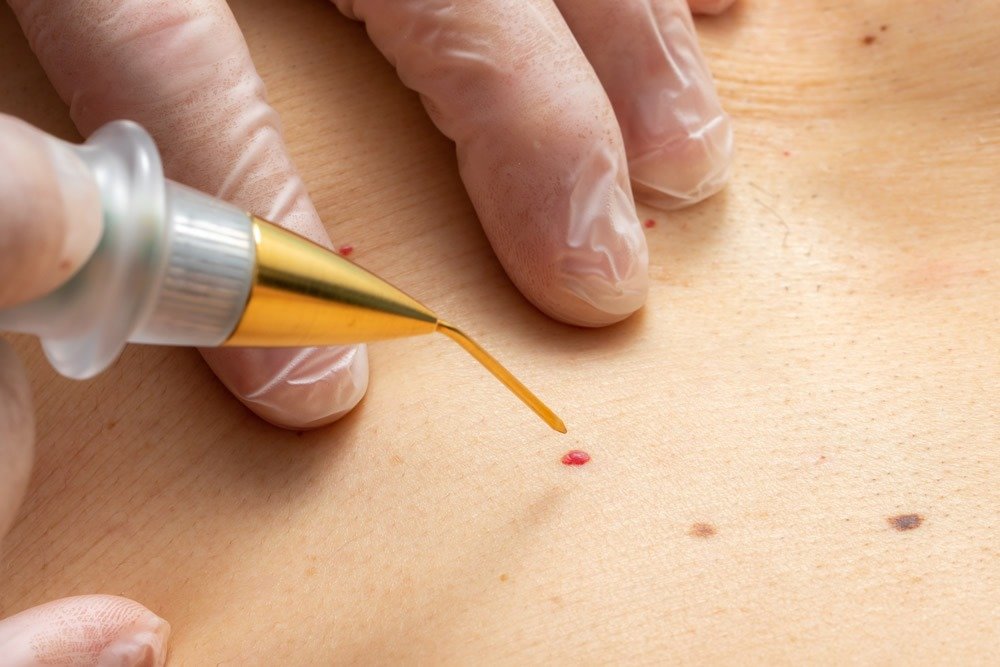Cherry Angiomas: How To Treat Them
Cherry angiomas are tiny red dots sometimes seen on the surface of the skin, and many people have questions about them. In this article, we will dive in deep to better understand this medical condition, discuss its causes and treatment options, and give some guidelines on when to worry and when not to.
What Are Cherry Angiomas?
Cherry angiomas are well-circumscribed (meaning they have a defined border or edge that distinguishes them from the surrounding skin) round dots that can vary in color from cherry red to darker purple, depending on how deep they are and the size of the blood vessel. They are benign growths consisting of a proliferation of blood vessel walls. These red growths can appear really cherry red or deeper purple-red, like Cabernet Merlot red wine.
Although cherry angiomas are generally harmless, if you notice a drastic change in size or symptoms, it's essential to visit a board-certified dermatologist to rule out any other conditions.
Who Gets Cherry Angiomas?
Anyone can develop cherry angiomas, regardless of race or gender. The real reason behind their development is still unknown, but several factors have been observed to contribute:
Age: Cherry angiomas tend to appear during mid to early adulthood and multiply over time.
Hereditary predisposition: If your family members have them, chances are you might develop them too.
Hormonal changes: Pregnancy and menopause can cause the appearance of cherry angiomas.
Underlying medical conditions: Certain medical conditions can bring about the appearance of cherry angiomas.
Why am I suddenly covered in cherry angiomas?
Cherry angiomas can occur in various locations on the body, with some areas being more commonly affected than others. While they can appear virtually anywhere on the skin, there are specific regions where they tend to manifest more frequently. The trunk, which includes the chest, abdomen, and back, is a common site for cherry angiomas. These growths often develop on the limbs as well, such as the arms and legs. Additionally, the face, particularly the cheeks and forehead, may also be prone to cherry angiomas. It's worth noting that they can emerge on other parts of the body too, including the neck, scalp, hands, feet, and even on mucous membranes. If you notice any unusual growths in these areas, it's advisable to consult a dermatologist for proper evaluation and guidance.
What are the Complications of Angiomas?
In most cases, cherry angiomas are asymptomatic and do not cause any discomfort or pain. However, in rare instances, individuals may experience certain symptoms related to these growths. Some people report occasional bleeding from a cherry angioma, especially if it becomes irritated or scratched. This bleeding is typically minimal and can be easily controlled with direct pressure. Additionally, there have been isolated reports of cherry angiomas becoming itchy or tender, although such occurrences are relatively uncommon. If you experience any unusual symptoms or have concerns about your cherry angiomas, consulting a dermatologist is recommended for proper evaluation and guidance.
What malignancy is associated with cherry angiomas?
In most cases, cherry angiomas are benign and nothing to worry about, especially if they are perfectly round, circumscribed, asymptomatic, and not changing. However, if the pattern changes suddenly or you're very young (less than 15 years old), it's essential to consult a medical professional to ensure there are no underlying issues.
How do You Get Rid of Red Cherry Angiomas at Home?
Contrary to popular belief, no over-the-counter cream can treat cherry angiomas. If the angiomas bother you, there are some treatment options available. But if you're comfortable with them, that's great too!
The best treatment option for cherry angiomas is laser therapy, specifically the pulsed dye laser (V-beam). This treatment targets hemoglobin, which makes up red blood cells, causing the angiomas to collapse and compress. After the laser treatment, the angioma turns dark purple and disappears in a few days.
Other treatment options include electrodesiccation, cryotherapy, and surgical removal, but these also carry the risk of post-inflammatory hyperpigmentation in darker skin types. Make sure to discuss with your dermatologist to determine the best treatment for your unique situation.
In conclusion, cherry angiomas are generally harmless, but it's essential to keep an eye on any changes or symptoms that may arise. If you choose to treat them, laser therapy is the most effective option for most people. Remember, always consult a dermatologist to ensure the best course of action for your specific case.

















